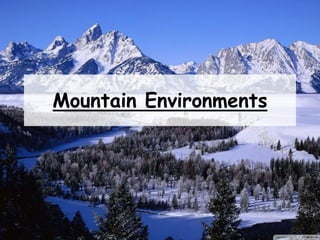
L1. introduction to mountain environments ap
- 2. What is today’s lesson about? Learning: What are the characteristics of a mountain environment? Doing: Complete a virtual fieldtrip to a mountainous environment Extending: What processes are acting on this environment? Key words: mountain, snow, ice, altitude.
- 3. Module Assessment • To monitor your progress throughout this module, stick the assessment sheet as a title page for this section and use throughout this half-term.
- 4. Homework • Mountain Environments Mini Research Project • You are going to carry out a mini research project of a particular mountain. • Your research should include: • Location – continent, country, mountain range • Height/size • Other interesting facts • A description of the landscape • Changes in temperature and weather conditions • Reference list of sources used
- 5. What do I already know about mountain environments? ‘High 5’ things you already know….
- 6. Mountain Challenge • Today we will be looking at the four key areas below. • You will need to collect information to broaden your knowledge of mountain environments. • 1. Highest point • 2. Fun Fact Find • 3. Magical Mountain Tour, with feeling! • 4. Why Me!
- 7. 1. Where are the Mountain Ranges of the World –(use the map at the back of you planner or share an Atlas) • Mountain Location Don’t forget to label the highest point onto your map….
- 8. 2. Fun Fact Find – learn and test Use the mini white boards to help you revise and test each other Mountains make up about one-fifth of the world's landscape, and provide homes to at least one-tenth of the world's people. Heights of mountains are generally given as heights above sea level. The world's highest peak on land is Mount Everest in the Himalayas. It is 8,850.1728 m (29,036 ft.) tall. Ben Nevis is also the highest mountain in Great Britain. The tallest known mountain in the solar system is Olympus Mons, located on Mars. There are mountains under the surface of the sea! Mountains occur more often in oceans than on land; some islands are the peaks of mountains coming out of the water. About 80 per cent of our planet's fresh water originates in the mountains. All mountain ecosystems have one major characteristic in common - rapid changes in altitude, climate, soil, and vegetation over very short distances. Plants that may be found on mountains include conifers, oak, chestnut, maple, junipers, stonecrops, campions, mosses, ferns and climbers. The highest 14 mountains in the world are all found in the Himalayas. In some mountainous areas the rivers are permanently frozen. These are called glaciers.
- 9. 3. Magical Mountain Tour • Watch the clip and write down your feelings on the Mountains in Motion - silent movie
- 10. 4. Why Me! • Stranded on top of a mountain - want to get down, feeling scared, read the extract from ‘The Climb’, and then climb down!!
- 11. Round UP